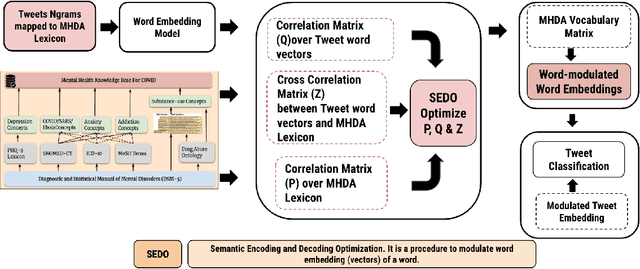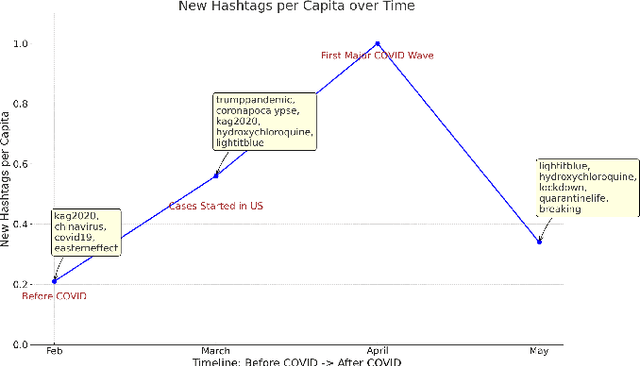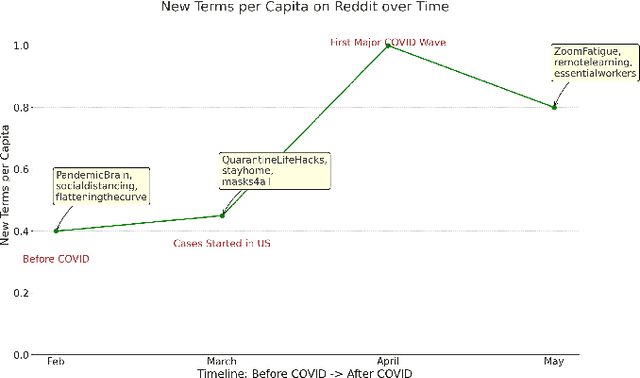Amit Sheth
YINYANG-ALIGN: Benchmarking Contradictory Objectives and Proposing Multi-Objective Optimization based DPO for Text-to-Image Alignment
Feb 05, 2025Abstract:Precise alignment in Text-to-Image (T2I) systems is crucial to ensure that generated visuals not only accurately encapsulate user intents but also conform to stringent ethical and aesthetic benchmarks. Incidents like the Google Gemini fiasco, where misaligned outputs triggered significant public backlash, underscore the critical need for robust alignment mechanisms. In contrast, Large Language Models (LLMs) have achieved notable success in alignment. Building on these advancements, researchers are eager to apply similar alignment techniques, such as Direct Preference Optimization (DPO), to T2I systems to enhance image generation fidelity and reliability. We present YinYangAlign, an advanced benchmarking framework that systematically quantifies the alignment fidelity of T2I systems, addressing six fundamental and inherently contradictory design objectives. Each pair represents fundamental tensions in image generation, such as balancing adherence to user prompts with creative modifications or maintaining diversity alongside visual coherence. YinYangAlign includes detailed axiom datasets featuring human prompts, aligned (chosen) responses, misaligned (rejected) AI-generated outputs, and explanations of the underlying contradictions.
Large Language Models for Mental Health Diagnostic Assessments: Exploring The Potential of Large Language Models for Assisting with Mental Health Diagnostic Assessments -- The Depression and Anxiety Case
Jan 02, 2025



Abstract:Large language models (LLMs) are increasingly attracting the attention of healthcare professionals for their potential to assist in diagnostic assessments, which could alleviate the strain on the healthcare system caused by a high patient load and a shortage of providers. For LLMs to be effective in supporting diagnostic assessments, it is essential that they closely replicate the standard diagnostic procedures used by clinicians. In this paper, we specifically examine the diagnostic assessment processes described in the Patient Health Questionnaire-9 (PHQ-9) for major depressive disorder (MDD) and the Generalized Anxiety Disorder-7 (GAD-7) questionnaire for generalized anxiety disorder (GAD). We investigate various prompting and fine-tuning techniques to guide both proprietary and open-source LLMs in adhering to these processes, and we evaluate the agreement between LLM-generated diagnostic outcomes and expert-validated ground truth. For fine-tuning, we utilize the Mentalllama and Llama models, while for prompting, we experiment with proprietary models like GPT-3.5 and GPT-4o, as well as open-source models such as llama-3.1-8b and mixtral-8x7b.
Time Series Foundational Models: Their Role in Anomaly Detection and Prediction
Dec 26, 2024Abstract:Time series foundational models (TSFM) have gained prominence in time series forecasting, promising state-of-the-art performance across various applications. However, their application in anomaly detection and prediction remains underexplored, with growing concerns regarding their black-box nature, lack of interpretability and applicability. This paper critically evaluates the efficacy of TSFM in anomaly detection and prediction tasks. We systematically analyze TSFM across multiple datasets, including those characterized by the absence of discernible patterns, trends and seasonality. Our analysis shows that while TSFMs can be extended for anomaly detection and prediction, traditional statistical and deep learning models often match or outperform TSFM in these tasks. Additionally, TSFMs require high computational resources but fail to capture sequential dependencies effectively or improve performance in few-shot or zero-shot scenarios. \noindent The preprocessed datasets, codes to reproduce the results and supplementary materials are available at https://github.com/smtmnfg/TSFM.
Exploring the Abilities of Large Language Models to Solve Proportional Analogies via Knowledge-Enhanced Prompting
Dec 01, 2024



Abstract:Making analogies is fundamental to cognition. Proportional analogies, which consist of four terms, are often used to assess linguistic and cognitive abilities. For instance, completing analogies like "Oxygen is to Gas as <blank> is to <blank>" requires identifying the semantic relationship (e.g., "type of") between the first pair of terms ("Oxygen" and "Gas") and finding a second pair that shares the same relationship (e.g., "Aluminum" and "Metal"). In this work, we introduce a 15K Multiple-Choice Question Answering (MCQA) dataset for proportional analogy completion and evaluate the performance of contemporary Large Language Models (LLMs) in various knowledge-enhanced prompt settings. Specifically, we augment prompts with three types of knowledge: exemplar, structured, and targeted. Our results show that despite extensive training data, solving proportional analogies remains challenging for current LLMs, with the best model achieving an accuracy of 55%. Notably, we find that providing targeted knowledge can better assist models in completing proportional analogies compared to providing exemplars or collections of structured knowledge.
PDDLFuse: A Tool for Generating Diverse Planning Domains
Nov 29, 2024Abstract:Various real-world challenges require planning algorithms that can adapt to a broad range of domains. Traditionally, the creation of planning domains has relied heavily on human implementation, which limits the scale and diversity of available domains. While recent advancements have leveraged generative AI technologies such as large language models (LLMs) for domain creation, these efforts have predominantly focused on translating existing domains from natural language descriptions rather than generating novel ones. In contrast, the concept of domain randomization, which has been highly effective in reinforcement learning, enhances performance and generalizability by training on a diverse array of randomized new domains. Inspired by this success, our tool, PDDLFuse, aims to bridge this gap in Planning Domain Definition Language (PDDL). PDDLFuse is designed to generate new, diverse planning domains that can be used to validate new planners or test foundational planning models. We have developed methods to adjust the domain generators parameters to modulate the difficulty of the domains it generates. This adaptability is crucial as existing domain-independent planners often struggle with more complex problems. Initial tests indicate that PDDLFuse efficiently creates intricate and varied domains, representing a significant advancement over traditional domain generation methods and making a contribution towards planning research.
Visual Counter Turing Test (VCT^2): Discovering the Challenges for AI-Generated Image Detection and Introducing Visual AI Index (V_AI)
Nov 24, 2024Abstract:The proliferation of AI techniques for image generation, coupled with their increasing accessibility, has raised significant concerns about the potential misuse of these images to spread misinformation. Recent AI-generated image detection (AGID) methods include CNNDetection, NPR, DM Image Detection, Fake Image Detection, DIRE, LASTED, GAN Image Detection, AIDE, SSP, DRCT, RINE, OCC-CLIP, De-Fake, and Deep Fake Detection. However, we argue that the current state-of-the-art AGID techniques are inadequate for effectively detecting contemporary AI-generated images and advocate for a comprehensive reevaluation of these methods. We introduce the Visual Counter Turing Test (VCT^2), a benchmark comprising ~130K images generated by contemporary text-to-image models (Stable Diffusion 2.1, Stable Diffusion XL, Stable Diffusion 3, DALL-E 3, and Midjourney 6). VCT^2 includes two sets of prompts sourced from tweets by the New York Times Twitter account and captions from the MS COCO dataset. We also evaluate the performance of the aforementioned AGID techniques on the VCT$^2$ benchmark, highlighting their ineffectiveness in detecting AI-generated images. As image-generative AI models continue to evolve, the need for a quantifiable framework to evaluate these models becomes increasingly critical. To meet this need, we propose the Visual AI Index (V_AI), which assesses generated images from various visual perspectives, including texture complexity and object coherence, setting a new standard for evaluating image-generative AI models. To foster research in this domain, we make our https://huggingface.co/datasets/anonymous1233/COCO_AI and https://huggingface.co/datasets/anonymous1233/twitter_AI datasets publicly available.
A Domain-Agnostic Neurosymbolic Approach for Big Social Data Analysis: Evaluating Mental Health Sentiment on Social Media during COVID-19
Nov 11, 2024



Abstract:Monitoring public sentiment via social media is potentially helpful during health crises such as the COVID-19 pandemic. However, traditional frequency-based, data-driven neural network-based approaches can miss newly relevant content due to the evolving nature of language in a dynamically evolving environment. Human-curated symbolic knowledge sources, such as lexicons for standard language and slang terms, can potentially elevate social media signals in evolving language. We introduce a neurosymbolic method that integrates neural networks with symbolic knowledge sources, enhancing the detection and interpretation of mental health-related tweets relevant to COVID-19. Our method was evaluated using a corpus of large datasets (approximately 12 billion tweets, 2.5 million subreddit data, and 700k news articles) and multiple knowledge graphs. This method dynamically adapts to evolving language, outperforming purely data-driven models with an F1 score exceeding 92\%. This approach also showed faster adaptation to new data and lower computational demands than fine-tuning pre-trained large language models (LLMs). This study demonstrates the benefit of neurosymbolic methods in interpreting text in a dynamic environment for tasks such as health surveillance.
Knowledge Graphs of Driving Scenes to Empower the Emerging Capabilities of Neurosymbolic AI
Nov 05, 2024Abstract:In the era of Generative AI, Neurosymbolic AI is emerging as a powerful approach for tasks spanning from perception to cognition. The use of Neurosymbolic AI has been shown to achieve enhanced capabilities, including improved grounding, alignment, explainability, and reliability. However, due to its nascent stage, there is a lack of widely available real-world benchmark datasets tailored to Neurosymbolic AI tasks. To address this gap and support the evaluation of current and future methods, we introduce DSceneKG -- a suite of knowledge graphs of driving scenes built from real-world, high-quality scenes from multiple open autonomous driving datasets. In this article, we detail the construction process of DSceneKG and highlight its application in seven different tasks. DSceneKG is publicly accessible at: https://github.com/ruwantw/DSceneKG
Overview of Factify5WQA: Fact Verification through 5W Question-Answering
Oct 05, 2024



Abstract:Researchers have found that fake news spreads much times faster than real news. This is a major problem, especially in today's world where social media is the key source of news for many among the younger population. Fact verification, thus, becomes an important task and many media sites contribute to the cause. Manual fact verification is a tedious task, given the volume of fake news online. The Factify5WQA shared task aims to increase research towards automated fake news detection by providing a dataset with an aspect-based question answering based fact verification method. Each claim and its supporting document is associated with 5W questions that help compare the two information sources. The objective performance measure in the task is done by comparing answers using BLEU score to measure the accuracy of the answers, followed by an accuracy measure of the classification. The task had submissions using custom training setup and pre-trained language-models among others. The best performing team posted an accuracy of 69.56%, which is a near 35% improvement over the baseline.
The Brittleness of AI-Generated Image Watermarking Techniques: Examining Their Robustness Against Visual Paraphrasing Attacks
Aug 19, 2024Abstract:The rapid advancement of text-to-image generation systems, exemplified by models like Stable Diffusion, Midjourney, Imagen, and DALL-E, has heightened concerns about their potential misuse. In response, companies like Meta and Google have intensified their efforts to implement watermarking techniques on AI-generated images to curb the circulation of potentially misleading visuals. However, in this paper, we argue that current image watermarking methods are fragile and susceptible to being circumvented through visual paraphrase attacks. The proposed visual paraphraser operates in two steps. First, it generates a caption for the given image using KOSMOS-2, one of the latest state-of-the-art image captioning systems. Second, it passes both the original image and the generated caption to an image-to-image diffusion system. During the denoising step of the diffusion pipeline, the system generates a visually similar image that is guided by the text caption. The resulting image is a visual paraphrase and is free of any watermarks. Our empirical findings demonstrate that visual paraphrase attacks can effectively remove watermarks from images. This paper provides a critical assessment, empirically revealing the vulnerability of existing watermarking techniques to visual paraphrase attacks. While we do not propose solutions to this issue, this paper serves as a call to action for the scientific community to prioritize the development of more robust watermarking techniques. Our first-of-its-kind visual paraphrase dataset and accompanying code are publicly available.
 Add to Chrome
Add to Chrome Add to Firefox
Add to Firefox Add to Edge
Add to Edge